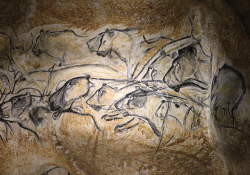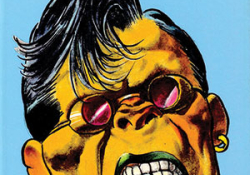World Music Videos Today
Over thirty-something years of music video, we have gotten what we might have expected of a new (?) art (?) form (?): the sedimentation of practices, followed by the stirring up of new possibilities; an ever-changing relationship with the technologies of production, distribution, and consumption; the formation of unanticipated links with other media forms; and an uneven but steady proliferation worldwide.
Like other short-form media, the music video is fairly amenable to experimentation. Yet it also grew up in the world of 1980s pop and rock, a world that, while liberating in some ways, was highly conventional in others. The music video early on took on two looks: the performance video and the concept video. Almost never entirely exclusive, these two approaches have persisted to the present. One might say that the stylistic history of the music video is a history of directors weaving performance and concept together in increasingly skillful and intriguing ways.
Looking at music videos across the globe, performance tends to outweigh concept. The collection of videos presented here includes some of each, as well as many that effectively combine the two.
Southeast Asia
Karacoma, “I.K.T.S.” (Brunei)
Set alongside this metal band’s performance is a straightforward concept of love gone wrong. Karacoma’s energy lashes out from its tight corner, a small studio simply decorated with two ornately patterned rugs, psychedelic wallpaper, and a red ceiling. Occasional use of a fish-eye lens cramps the room even further. This seething, claustrophobic space contrasts with the black-and-white unfolding of the tortured love story of singer Sam and bassist Wayne. About halfway through this video I found myself thinking, Okay, haven’t we seen enough already of women being objectified and abused in music videos? Here the violence is rougher and the ending unexpectedly pleasing.
Alexandra Bounxouei, “My Radio” (Laos)
Laos (Lao PDR) is not exactly a hotbed of film and video production. The first Laotian film I ever saw was At the Horizon, directed by Anysay Keola. Despite a budget of only about $20,000, the film was the surprise hit of the Lifescapes Southeast Asian Film Festival in Chiang Mai, Thailand, in 2012, with a strong script, compelling editing, and an astonishingly professional look. Its makers claim rightfully, on the website for this film, that with it began a “new chapter” in the history of the Lao film industry, and music video plays a part in this chapter as well. In “My Radio,” the plenitude of digital-audio effects is matched by an array of digital- video effects that make this look like a Vientiane version of Lady Gaga’s “Bad Romance” (though Bounxouei’s wardrobe is shallower and tamer).
Rudra, “Hymns from the Blazing Chariot” (Singapore)
A congenial introduction on tabla as the camera scans across a mountainous landscape giving way to Rudra thrashing out its unusual death metal on the peaks. Rudra’s apocalyptic sound seems somehow well suited to video game–like depictions of epic Hindu battles. Not your grandmother’s BJP.
South Asia
Farhad Darya, “Zhwand Khkolai Dai” (Afghanistan)
The mountains in the background of this video have a decidedly different character, as a congenial and smartly dressed Farhad Dayra rides his red mountain bike along a gravel road. The chorus, “Zhwand Khkoilai Dai,” rendered in the subtitles as “Life Is Beautiful,” is typically paired with shots of Afghans from all walks of life: individuals cheerfully animated by Darya’s song and crowds dancing and singing at an open-air concert. This is an uplifting call for peace, not at all cloying.
Dinesh Subasinghe featuring Chamika Sirimanne, “E kale” (Sri Lanka)
Like many other musicians around South Asia, Dinesh Subasinghe works widely, ranging from classical to pop styles and composing for film and television in between. This video, directed by Ranuka Fernando, is a cheerfully corny failed love story, very much in the style of the comedy skits popular on television across the subcontinent.
Lochan Rijal, “Paurakhi” (Nepal)
Decades before Bhusan Dahal introduced Kathmandu TV viewers to the videos of Michael Jackson and others, Nepali filmgoers saw the songs of Bollywood and the occasional Nepali film on the big screen. Film set the stage for local music video production, and even stand-alone music videos often look like they were lifted from films. But Lochan Rijal is no ordinary singer, “Paurakhi” no ordinary song. Lochan Rijal studied and teaches at the Department of Music of Kathmandu University and plays the archaic arbaja and the more widely known sarangi here. “Paurakhi,” a song about Nepali migrant laborers in India, appears not in a feature film but in the documentary Leaving Nepal, directed by Gopal Koirala.
East Asia
Six City, “Duxmen” (China)
Not surprisingly, youth from minority groups around the world are often drawn to the potential of rap and hip-hop for political or social protest. Six City is an Uyghur rap crew, and its song “Duxmen” (Enemy) has a rough sound and look. The sound in part resembles Chinese musician Cui Jian’s experimentation with rap styles. The look has neither the washed-out colors of West Coast rap nor the more lurid colors that sometimes appear in East Coast rap; instead, black space seems to fill the screen, and the rappers move in and out of the shadows.
Lee Hyori, “Miss Korea” (Korea)
The black-and-white fashion photography of this video fits perfectly with the song’s musical sensibilities. There’s something quite wonderful about putting women in black-and-white striped outfits against a black-and-white striped wall, a shot that appears fleetingly after the first chorus and that gets used more extensively later on. The drag queen versions of “Miss Korea” are a nice touch.
Polysics, “Electric Surfin’ Go-go” (Japan)
Picture Devo as a quartet of Japanese schoolgirls . . . but then the insane energy of this video explodes in other directions. Pour yourself a triple espresso before watching this.
Australia and the Pacific
Troy Cassar-Daley, “Home” (Australia)
The look, feel, and sound of this video would make me think I was in Oklahoma, yet Troy Cassar-Daley is a well-known Australian country musician. While he emphasizes the importance of family and home, he does not play up the fact that his mother, Irene, is Aboriginal. This is no imitation, though: country styles have their own broad appeal and distinctive history in Australia and among Australian Aboriginals.
Maisey Rika, “Tangaroa whakamautai” (New Zealand)
Beautiful landscape and underwater photography meld together in this majestic video by Maori singer-songwriter Maisey Rika. This is essentially a praise song to Tangaroa, the god of the sea. Often I find that there is one especially delicious moment in a music video, one that somehow stands outside of the flow, yet one that immediately pulls me back in: here it comes in the unexpected slowing of a shot of a wave to catch the beginning of a vocal line.
Vanessa Quai, “Rise Up” (Vanuatu)
Reggae has been adopted around the Pacific as an expression of black pride. “Rise Up” plays out the dialectic of ebullience and indignation so characteristic of reggae, Vanessa Quai’s joyful call to arms matched to images of Ni-Vanuatu performance and protest.
Central and South America
Café Tacvba, “Eres” (Mexico)
A teenage schoolboy doodles his infatuation with a classmate. The members of Café Tacvba, a well-known band noted for its amalgamation of diverse styles, only make fleeting appearances on students’ notebook covers in this beautiful and charming concept video.
Mallu Magalhães, “Sambinha bom” (Brazil)
By contrast, this is a straight-ahead performance video: the singer appears front and center in almost every shot. Yet it is mesmerizing. The one-finger piano solo that sits in the middle of the song is surrounded by uncanny rhythmic interplay, the editing picking out different aspects of the musical accompaniment.
Bunji Garlin, “Differentology” (Trinidad and Tobago)
Vikings and gladiators, together at last in the Caribbean. Music video seems especially well suited to the run-up to Carnival, as performers seek to establish a theme for the year not only in sound but also in look. Just when this video starts to feel like a promo for the Ministry of Tourism of the Republic of Trinidad and Tobago, guitarist Nigel Rojas takes a short turn and four costumed figures appear, unsettling and completing the loose narrative framework.
Europe
Papa Topo, “En un momento” (Spain)
Papa Topo’s lushly retro sound is complemented nicely by Lluís Prieto’s lushly futuristic video, which borrows elements from classic science-fiction films and television shows. Paulita Demaíz, then the lead singer of the group, appears on the TV talk show ¿Quien sabe ande? to tell her unbelievable story of space travel, and Adrià Arbona Orero, the founder of the group, stars as an astronaut who can’t quite follow directions.
Kiscsillag, “Légyszíves” (Hungary)
Bundled up in a fur-lined coat and a long red-and-white scarf, actress Kriszta Wieden forlornly drags a wooden sled through Budapest. Her demeanor lightens as she escapes the city and traipses through the snowy woods. This is an unusual take on the performance video, for while the band does appear, it is Wieden who lip-synchs almost all of the lyrics—and interspersed across the video are a few shots of her on a concert stage, as if she is the lead singer of the band.
Zdob și Zdub, “Moldovenii s-au născut” (Moldova)
Intrepid but slightly befuddled Italian tourist Marco Giovanni arrives at the Chișinău airport in search of the older woman on the cover of a Zdob și Zdub CD he holds up to show a helpful taxi driver, who promptly whisks him off to her village. The band, which has twice competed in the Eurovision Song Contest, departs from the turbo folk popular around Eastern Europe in the 1990s by drawing from punk and hip-hop and infusing its work with the zany eclecticism of an Emir Kusturica film.
Middle East
Sertab Erener, “Öyle de güzel” (Turkey)
Often the sets of music videos seem rather spare. The set for “Öyle de güzel” is comparatively ornate. It is as if the sprawling splendor of Randee St. Nicholas’s video for Prince’s “Gett off” has been moved to a clearing in the woods. The dimensions of song and set seem well suited to one another.
Acrassicauda, “Garden of Stones” (Iraq)
Acrassicauda was featured in the 2007 documentary Heavy Metal in Baghdad. Metal bands have stuck the closest to the performance video over the years. Images of the sometimes aggressive, sometimes virtuosic movements of the musicians do seem to lend power to the music. Grainy black-and-white footage of destruction give further weight to this video.
Amal Maher, “Rayeh beya feen” (Egypt)
A music video is often the springboard for fashioning a new image for a singer: Madonna, for example, invented and reinvented herself not only through musical style but also through music video throughout her career. Amal Maher made a name for herself as a teenager singing the songs of superstar Umm Kulthum. This video, for the first track of her 2011 album Aaraf menien, seems hell-bent on making her into a star in her own right—and, with over 3,600,000 views on YouTube, it seems that director Sherif Sabri may have succeeded.
Africa
Fatoumata Diawara, “Sowa” (Mali)
“Sowa” begins with puzzling and disturbing images of the singer encased in plastic wrap; these images begin to give way to shots of her singing and playing the guitar. This is the second track on her 2011 album Fatou; in the CD booklet she writes, “This is a subject that is close to my heart. Whatever your situation in life, don’t give your children up.” The plastic wrap seems suggestive of the feeling of being trapped by life’s circumstances, and just before the second verse we see Diawara peeling off the last of the plastic wrap. Male dancers appear right after the third chorus, an unexpected yet effective addition to this song addressed to mothers.
Rajery, “Tantsaha” (Madagascar)
As the digital production tools now common in music video have become more easily available, it is perhaps surprising that music video remains squarely a part of the popular music industries of the world. It is rare to see a video for a jazz saxophonist, a classical sitar player, a Balinese gamelan ensemble. One might guess that Africa, where popular has merged with traditional in so many ways, would hold exceptions. But in fact, videos by Afropop musicians like Rajery still seem to be something of a rarity.
Nomisupasta, “What Kind of Love” (South Africa)
At 790 views (about a dozen of which are mine), this video is not about to go viral, but it is a powerful and compelling blend of performance and concept. Producer and director Donna Sibande’s crew, Lady D Films, created this video during the 48 Hour Music Video Project in Johannesburg in 2012.






